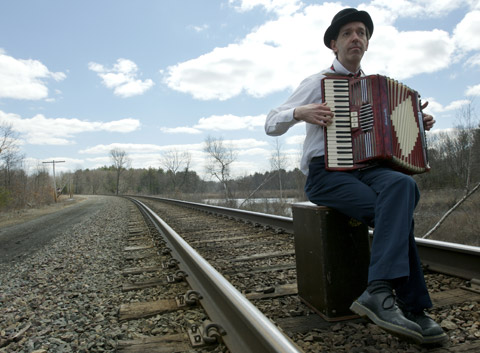
IMPURE THOUGHTS The Ghost Train Orchestra went back to the ’20s without nerding out. |
If part of what's grabbed you about HBO's Boardwalk Empire and Ken Burns and Lynn Novick's Prohibition is the music, then you owe it to yourself to get over to the Regattabar on October 18 to catch Brian Carpenter's Ghost Train Orchestra. This is music from the heart of the Jazz Age that still has a raucous immediacy. In fact, just about every track on the band's Hothouse Stomp (Accurate) has the hookiness of a pop hit.Carpenter has long filtered his taste for old-time music through an avant-garde sensibility. He's used his band Beat Circus as a platform for exploring circus music as well as his own sing-songwriter inclinations. Tuba, banjo, saw, and accordion are regular parts of his instrumentation.
The Ghost Train Orchestra began in October of 2006 when Carpenter was asked to provide music for a weekend-long celebration of the 90th anniversary of the Regent Theatre in Arlington. The show, Voltaic Vaudeville, would return the old hall to its roots with a variety of acts. Carpenter — with the help of Cambridge jazz gadfly, impresario, and record collector Rob Chalfen (of Outpost 186) — dug into research of the period.
What he found accounts for the album's very specific subtitle: The Music of 1920s Chicago and Harlem. This was jazz in its transitional period between the small groups of New Orleans and Chicago and the big bands of the Swing Era. Here was the constant collective dialogue of the early period combined with the sophisticated arrangements that would be the hallmark of swing. The CD doesn't include what we usually hear from the '20s — Louis Armstrong, Jelly Roll Morton, early Ellington. What Carpenter came up with instead were Charlie Johnson's Paradise Orchestra, McKinney's Cotton Pickers, Fess Williams's Royal Flush Orchestra, and Tiny Parham and His Musicians. What these bands often feature are startling suite-like juxtapositions, roaring variegated textures, buoyant themes, dance rhythms that alternate between old-fashioned oom-pah stomp and helter-skelter Charlestons and Lindy Hops. And plenty of blues.
When Carpenter presented the music at the first rehearsal, he was stunned. "It didn't sound anything like the records." But in a good way. For one thing, the tuba on those recordings was often played by bassists who did little more than hit the root on 2 and 4. Ron Caswell — a regular with Carpenter — is a virtuoso tubist. He read the charts and improvised lines that surged and sang. "He brought the second-line New Orleans sound in, which they never would have done back then."
Which is another point Carpenter makes. "This isn't a retro band. We're bringing our own sensibility to it." Looking back at his research, he says, "I didn't nerd out on this stuff." How's that? "I mean, there are people who listen only to this music and won't listen to anything else."
So despite Carpenter's hard work transcribing from recordings, the solos take off in directions decidedly post-Swing — in fact, post-everything. What you get are tight ensembles and some gorgeous arrangements that glide from bold stomping themes to lyric, high-reed laments, and concise "outside" digressions. On disc, Caswell's tuba, beautifully recorded, leaps out the speakers. Jordan Voelker alternates viola with saw (amazingly on pitch). Mazz Swift plays violin and sings a couple of tunes. The avant-jazz banjo player Brandon Seabrook, another Carpenter stalwart, is also on hand.